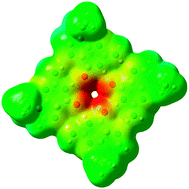Accueil du site > Production scientifique > Guanine tetrads : an IRMPD spectroscopy, energy resolved SORI-CID, and computational study of M(9-ethylguanine)(4)(+) (M = Li, Na, K, Rb, Cs) in the gas phase
Guanine tetrads : an IRMPD spectroscopy, energy resolved SORI-CID, and computational study of M(9-ethylguanine)(4)(+) (M = Li, Na, K, Rb, Cs) in the gas phase
Date de publication: 27 mars 2015
M. Azargun, T.D. Fridgen
Phys. Chem. Chem. Phys. 17 25778-25785 (2015). DOI
Travail réalisé sur le site de l’Université Paris Sud.
Abstract

The intrinsic properties of the alkali metal cationized G-tetrads, M(9eG)4+ (M = Li, Na, K, Rb, Cs) composed of 9-ethylguanine (9eG), were studied by a combination of mass spectrometric techniques. The gas phase structures were probed by infrared multiple photon dissociation (IRMPD) spectroscopy in both the fingerprint region (900–1850 cm−1) and the N–H/C–H stretching region (2700–3800 cm−1). The gas phase structures were found to be similar for all five complexes and most consistent with the metal-centred G-tetrad structure. Energy-resolved CID was also used to compare the gas phase stabilities of the G-tetrads and showed that Na(9eG)4+ was more stable than Li(9eG)4+ followed by the K+, Rb+, and Cs+ G-tetrads in order. The experimental energy ordering was reproduced by electronic structure calculations of the energies. Furthermore, the computations also showed that the lower stability to loss of 9-ethylguanine for the Li+ complex could be due to a strong destabilization of the neutral G-tetrad due to the persistence toward maximizing the ion–dipole interactions while also maintaining hydrogen bonding interactions.








